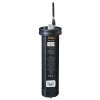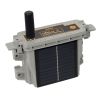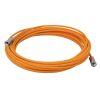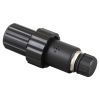Solinst LevelVent 5 Water Level Loggers
The Solinst LevelVent 5 provides instantly accurate water level data without barometric compensation.
Features
- Accurate to +/-0.05% full scale water level data
- 10-year integrated battery based on 1 reading per minute
- Extremely durable vented cable with no desiccants to replace
- Free ground shipping
- Expedited repair and warranty service
- Lifetime technical support
- More
Overview
The Solinst LevelVent 5 provides a highly-accurate datalogger designed to record water level and temperature measurements during shallow groundwater and surface water deployments. The LevelVent 5 logger contains pressure and temperature sensors, a battery, memory for up to 150,000 data logs, and a hydrophobic filter within a 22mm x 173mm (7/8" x 6.8") stainless steel housing with a corrosion-resistant coating.
Sturdy
The LevelVent uses a gauged pressure transducer; it is open to the atmosphere via a vented cable to the wellhead. The compact LevelVent wellhead is designed to fit in a Solinst 2" Well Cap Assembly and provides easy connection for communication accessories. The vented cable and Solinst LevelVent 5 logger are protected from moisture by permanent, built-in desiccants and hydrophobic filters in the logger and the wellhead.
Highly Accurate
The vented pressure transducer is made of Hastelloy, making it extremely durable and accurate in a wide range of temperature and monitoring conditions. The sensor provides an accuracy of 0.05% FS, and can withstand 2 times over-pressure without permanent damage.
In The News
From Paddles to Phytoplankton: Studying Vermont’s Wildest Lakes
For six months of the year, Rachel Cray, a third-year PhD student at the Vermont Limnology Laboratory at the University of Vermont, lives between a microscope and her laptop, running data. For the other six months, she is hiking and canoeing four of Vermont’s lakes, collecting bi-weekly water samples. Cray studies algal phenology across four lakes in Vermont, US, that have low anthropogenic stress—or in other words, are very remote. Funded by the National Science Foundation Career Award to Dr. Mindy Morales, the lakes Cray researches part of the Vermont Sentinel Lakes Program, which studies 13 lakes in the area and, in turn, feeds into the Regional Monitoring Network, which operates in the Northeast and Midwest US.
Read MoreReimagining Water Filtration: How Monitoring and Science Enhance FloWater Filtration Systems
Over 50% of Americans think their tap water is unsafe , according to the Environmental Working Group (EWG). Other recent surveys have found that number to be as high as 70% of persons surveyed. Whether due to increased public awareness of water quality issues or confusion about how municipal water sources are regulated, there is a clear distrust of tap water in the United States. According to industry expert Rich Razgaitis, CEO and co-founder of the water purification company FloWater, this issue creates a damaging cycle. Razgaitis explained that the health and environmental problems associated with contaminated water aren’t the only issues. As people become increasingly aware that some tap water is unsafe, they resort to bottled water.
Read MoreMonitoring New Hampshire’s Aquatic Ecosystems: Continuous Data Collection in the Lamprey River Watershed
New Hampshire’s aquatic ecosystems provide a range of ecosystem services to the state and region. Resources and services like clean water, carbon storage, climate regulation, nutrient regulation, and opportunities for recreation all depend on New Hampshire’s aquatic ecosystems remaining healthy. Jody Potter, an analytical instrumentation scientist at the University of New Hampshire (UNH), is studying these aquatic ecosystems in hopes of developing an improved understanding of ecosystem services and their interactions with climate change, climate variability, and land use changes. [caption id="attachment_39799" align="alignnone" width="940"] Aquatic sensors in the Merrimack River in Bedford, NH, with I-293 in the background.
Read More





































